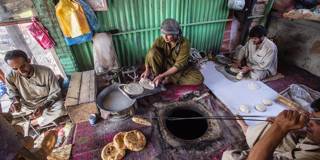It would cost an estimated $4.4 billion annually to meet the world’s residential clean-cooking needs – far more than what is currently available. While that figure is not small, it is dwarfed by the costs of inaction.
FREETOWN, SIERRA LEONE – Each year, exposure to household air pollution (HAP) kills 4.3 million people – more than HIV/AIDS, malaria, and tuberculosis combined. HAP is produced when households use antiquated fuels – such as firewood, coal, crop waste, and kerosene – for cooking and heating, so ending HAP-related deaths is as straightforward as delivering clean-cooking solutions.
Yet the world hasn’t done it. Across Africa, for example, over 80% of people still rely on biomass as their primary source of energy. In my home country, Sierra Leone (one of the five most vulnerable countries to climate change), less than 20% of the population has electricity, while over 90% rely on charcoal and firewood for cooking. If current trends hold, Africans will still be using such fuels to cook in 2050.
It would cost an estimated $4.4 billion annually to meet the world’s residential clean-cooking needs – far more than what is currently available. While that figure is not small, it is dwarfed by the costs of inaction. Beyond its devastating effects on human health – HAP is the second-largest risk factor for death and disability in Sub-Saharan Africa – reliance on non-renewable wood fuels for cooking contributes up to one gigaton of CO2 emissions annually, or about 2% of total emissions.

FREETOWN, SIERRA LEONE – Each year, exposure to household air pollution (HAP) kills 4.3 million people – more than HIV/AIDS, malaria, and tuberculosis combined. HAP is produced when households use antiquated fuels – such as firewood, coal, crop waste, and kerosene – for cooking and heating, so ending HAP-related deaths is as straightforward as delivering clean-cooking solutions.
Yet the world hasn’t done it. Across Africa, for example, over 80% of people still rely on biomass as their primary source of energy. In my home country, Sierra Leone (one of the five most vulnerable countries to climate change), less than 20% of the population has electricity, while over 90% rely on charcoal and firewood for cooking. If current trends hold, Africans will still be using such fuels to cook in 2050.
It would cost an estimated $4.4 billion annually to meet the world’s residential clean-cooking needs – far more than what is currently available. While that figure is not small, it is dwarfed by the costs of inaction. Beyond its devastating effects on human health – HAP is the second-largest risk factor for death and disability in Sub-Saharan Africa – reliance on non-renewable wood fuels for cooking contributes up to one gigaton of CO2 emissions annually, or about 2% of total emissions.